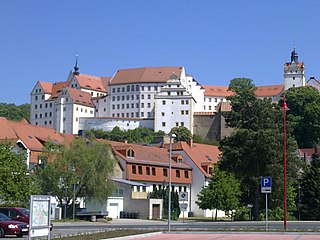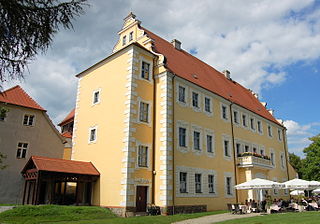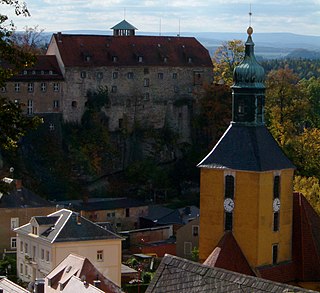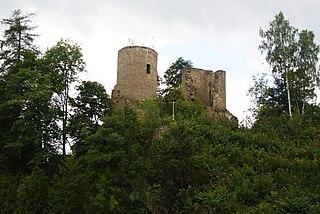
Colditz is a small town in the district of Leipzig, in Saxony, Germany. It is best known for Colditz Castle, the site of the Oflag IV-C POW camp for officers in World War II.

Colditz Castle is a Renaissance castle in the town of Colditz near Leipzig, Dresden and Chemnitz in the state of Saxony in Germany. The castle is between the towns of Hartha and Grimma on a hill spur over the river Zwickauer Mulde, a tributary of the River Elbe. It had the first wildlife park in Germany when, during 1523, the castle park was converted into one of the largest menageries in Europe.

Lusatia is a historical region in Central Europe, split between Germany and Poland. Lusatia stretches from the Bóbr and Kwisa rivers in the east to the Pulsnitz and Black Elster rivers in the west, and is located within the German states of Saxony and Brandenburg as well as in the Polish voivodeships of Lower Silesia and Lubusz. Lusatia's central rivers are the Spree and the Lusatian Neisse, which constitutes the border between Germany and Poland. The Lusatian Mountains, separate Lusatia from Bohemia in the south. Lusatia is traditionally divided into Upper Lusatia and Lower Lusatia.

Saxon Switzerland is a hilly climbing area and national park in the Elbe Sandstone Mountains. It is located around the Elbe valley south-east of Dresden in Saxony, Germany, adjoining Bohemian Switzerland in the Czech Republic. Together with the Czech part, the region is known as Saxon-Bohemian Switzerland.

Stolpen is a town in the district of Sächsische Schweiz-Osterzgebirge, in Saxony, Germany. It is a historical town, that grew at the foot of the Schloßberg with the castle Burg Stolpen.

Mühlberg is a town in the Elbe-Elster district, in the southwesternmost part of Brandenburg, Germany. It is located on the right bank of the river Elbe, about halfway between Riesa to the south and Torgau to the northwest. It is about 60 km east of Leipzig. It is accessed by the Bundesstraße 182 on the left bank of the Elbe, connected with the town by a bridge, opened in 2008. Mühlberg consists of the Ortsteile Mühlberg, Altenau, Brottewitz, Fichtenberg, Koßdorf and Martinskirchen.

The Falkenstein is one of the best-known climbing peaks in Saxon Switzerland. It is situated near the rocky Schrammsteine ridge southeast of the town of Bad Schandau. The Falkenstein is nearly 90 m high and consists of sandstone. In the Middle Ages there were fortifications on top of the rock. Even today, the steps carved into the rock are still visible.

Lübben (Spreewald) is a town of 14,000 people, capital of the Dahme-Spreewald district in the Lower Lusatia region in Brandenburg, in eastern Germany.

Königstein is a town on the river Elbe in Saxony in Germany. Königstein lies in the Sächsische Schweiz-Osterzgebirge District and had a population of 2,089 in 2018. It includes land on both banks of the Elbe, but the centre and most of the town lies to the south of the river. The Königstein Fortress is situated above and to the south-west of the town.

Friesack is a town in the Havelland district, in Brandenburg, in north-eastern Germany. It is situated 22 km (14 mi) northeast of Rathenow, and 25 km (16 mi) southwest of Neuruppin. It is known for its Mesolithic archaeological site.

Hohnstein is a town located in the Sächsische Schweiz-Osterzgebirge district of Saxony, in eastern Germany. As of 2020, its population numbered a total of 3,262.

Oflag IV-A was a World War II German POW camp for officers located in the 15th-century Burg Hohnstein, in Hohnstein, Saxony.

Stalag IV-A Elsterhorst was a World War II German Army prisoner-of-war camp located south of the village of Elsterhorst, near Hoyerswerda in Saxony, 44 kilometres (27 mi) north-east of Dresden. It held Polish, French, Belgian, British, Serbian, Soviet, Dutch, Italian, American, Slovak, Czech, Bulgarian and other Allied POWs.

Saxon Switzerland National Park, is a national park in the German Free State of Saxony, near the Saxon capital Dresden. It covers two areas of 93.5 km2 (36.1 mi2) in the heart of the German part of the Elbe Sandstone Mountains, which is often called (the) Saxon Switzerland.

Šaunštejn Castle is a rock castle near Vysoká Lípa (Hohenleipa) in the Bohemian Switzerland in the Czech Republic. Today only a few ruins remain of the original castle. Preserved are the foundations of the wooden superstructure, several rooms that were chiselled-out of the rock and the cistern.

Neurathen Castle, which was first mentioned by this name in 1755, is located near the famous Bastei rocks near Rathen in Saxon Switzerland in the German state of Saxony. This was once the largest rock castle in the region, but today only the rooms carved out of the rock, passages, the cistern and the beam supports of the former wooden superstructure have survived. In the years 1982–1984 parts of the extensive castle were used to build the open-air museum.

Dohna Castle on the once important medieval trade route from Saxony to Bohemia was the ancestral castle seat of the Burgraves of Dohna. Of the old, once imposing double castle only a few remnants of the walls remain. The ruins of the old castle are located on the hill of Schlossberg near the subsequent suburb of the town of the same name, Dohna, in the district of Sächsische Schweiz-Osterzgebirge in Saxony, Germany.

Lauterstein Castle, in German Burg Lauterstein, also called Burgruine Niederlauterstein, is a medieval castle in Niederlauterstein, town of Marienberg, Erzgebirgskreis, Saxony. It has been a ruin since the Thirty Years' War.

Nazi Germany operated around 1,000 prisoner-of-war camps during World War II (1939-1945).






















